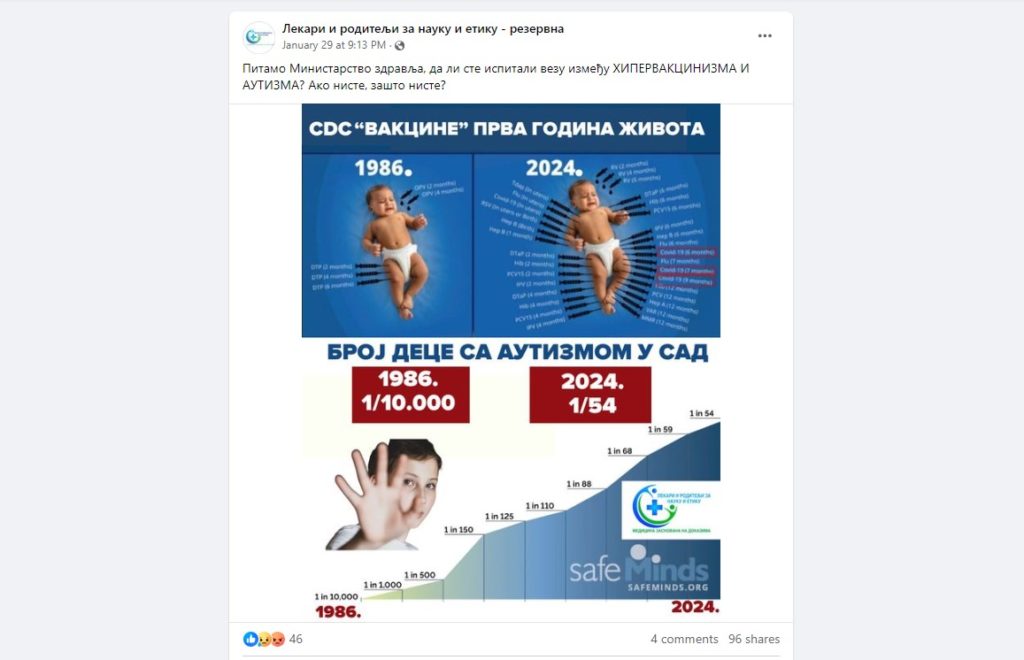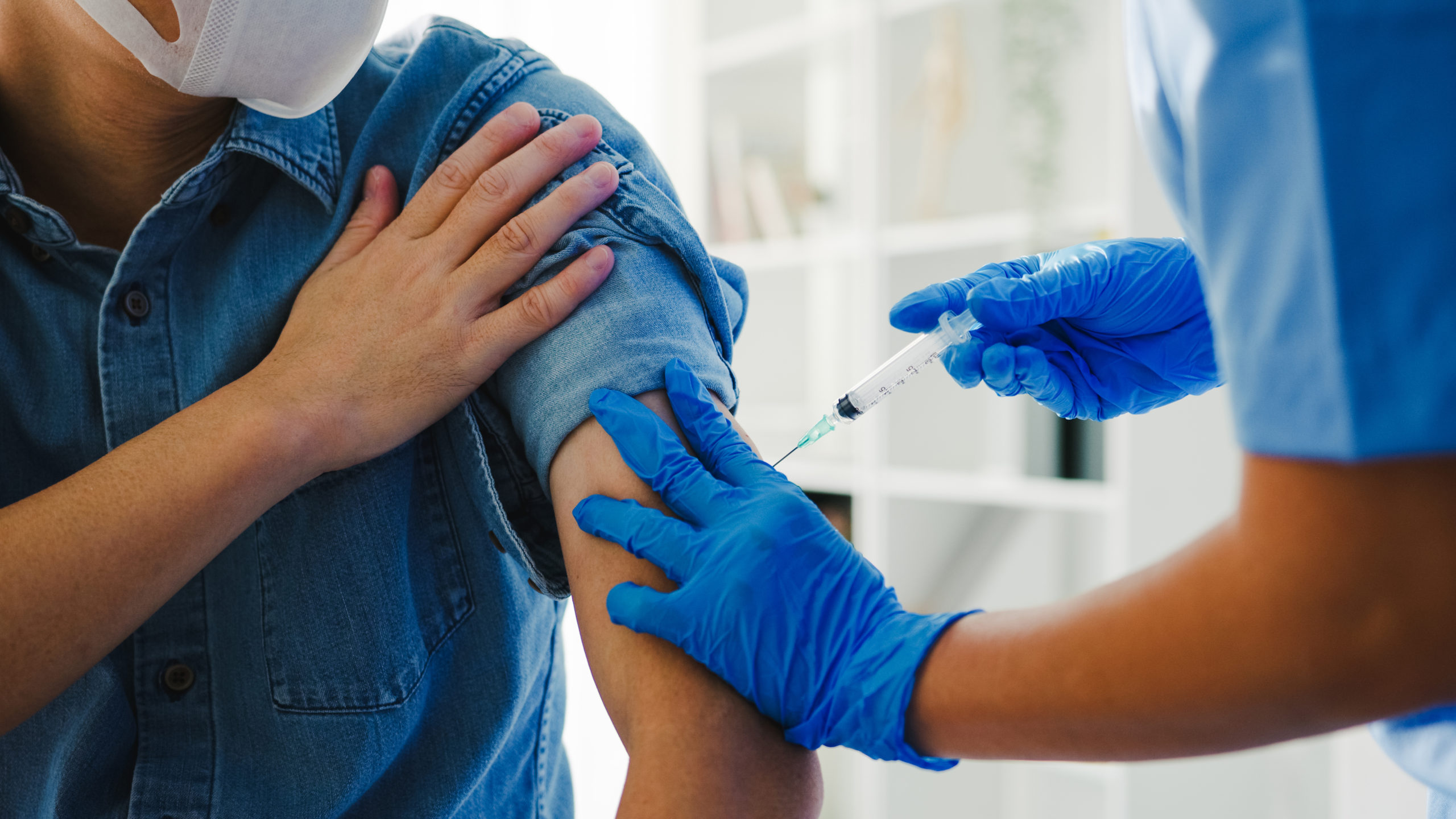Original article (in Serbian) was published on 5/2/2024; Author: Marija Vučić
Vaccination has once again become a prominent topic in public discourse following reports that five infants died from whooping cough in recent months. Despite these tragedies, the country’s leading anti-vaxxer group, “Physicians and Parents for Science and Ethics” (LRNE), continues unabated in its efforts to dissuade parents from vaccinating their children. They employ baseless and inaccurate arguments to support their stance. In a social media post published at the end of January, they claimed that children are “over-vaccinated” and alleged that this leads to a higher rate of autism. They referenced data from the US Centers for Disease Control and Prevention (CDC), while simultaneously disregarding the agency’s explicit clarification that there is no evidence to suggest vaccines cause autism.
From 1986 to today, a lot has changed in the USA, and indeed the world: sugar intake has increased, as well as plastic pollution, and a shift in the average age of first-time parents. Likewise, the rate of some diseases such as cancer, diabetes or – autism has increased.
Among the myriad changes over the past nearly four decades that could potentially influence the increase in autism rates, some individuals have singled out vaccines as the primary factor. The argument put forth by “Physicians and Parents for Science and Ethics,” a prominent anti-vaxxer group in Serbia that gained notoriety during the pandemic, centers on the claim that the alleged “over-vaccination” of children in the USA has contributed to a higher incidence of autism.

However, this assertion is incorrect.
The claim that in 1986 in the USA, infants up to one year old received only two vaccines (DTP and OPV in multiple doses), in contrast to the present where they allegedly receive many times more, is misleading and incorrect. According to the History of Vaccines website, initiated by the professional association the College of Physicians of Philadelphia, the period from 1985 to 1994 actually saw the distribution of five vaccines in the United States: DTP (diphtheria, tetanus, whooping cough), OPV (polio), MMR (measles, mumps, rubella), Hib (Haemophilus influenzae type b, which can lead to ear infections, meningitis, etc.), and Hepatitis B.
Currently, in some U.S. states, infants up to one year of age are required to receive ten vaccines. These include the original five vaccines plus RSV (respiratory syncytial virus vaccine, recommended if the mother has not been vaccinated), rotavirus, pneumococcal, influenza, Hepatitis A, and COVID-19. Typically, these vaccines are administered in multiple doses over several months (including booster shots).
The requirement for specific vaccinations in the United States varies by state. For instance, CDC data from 2019 indicates that MMR (measles, mumps, rubella), DTP (diphtheria, tetanus, pertussis), polio, and chickenpox vaccines are mandatory for kindergarten enrollment across all states. However, hepatitis vaccines are not universally required throughout the U.S.
Regarding autism, data from 1986 on the prevalence of this disorder is not readily available. Nonetheless, it’s widely acknowledged that the rate of autism diagnoses has been on the rise. In 2000, the CDC reported that one in every 150 children was diagnosed with autism. By 2020, this rate had increased to one in every 36 children.
Paul Offit, director of the Vaccine Education Center at the Children’s Hospital of Philadelphia, has addressed this topic in a report by AFP, emphasizing that the surge in autism rates cannot be attributed to vaccinations, as there is no scientific evidence supporting such a claim. Instead, the increase should be attributed to improvements in diagnostic methods and awareness.
“The most obvious explanation is that this is a much better-recognized phenomenon, much more discussed phenomenon,” he said. In other words, there is now greater awareness of autism within the scientific community and the public, enhanced diagnostic tools are available, the disorder is more precisely defined, and it is easier to identify.
This perspective is reinforced by a 2011 scientific article by researcher Judith Miles from the University of Missouri’s Center for Autism. In her review of decades of research on autism, Miles found that nearly all epidemiological analyses currently suggest the perceived “autism epidemic” does not represent a real increase in the prevalence of autism spectrum disorders. Instead, it reflects heightened public and professional awareness, leading to more comprehensive case reporting and an expansion of diagnostic criteria.
The expansion and refinement of diagnostic criteria for autism are further illustrated by changes in the identification of associated conditions. Judith Miles points out that earlier studies recorded intellectual disabilities alongside autism and other pervasive developmental disorders in as many as 70 percent of children. In contrast, more recent research shows intellectual difficulties in only about 30 percent of children diagnosed with autism.
“This is in accordance with the practice that children who have more functional abilities, fewer speech disorders and who are less aggressive, were not included in older epidemiological studies”, wrote Miles.
While LRNE members selectively reference CDC data to support their stance, they conspicuously disregard other critical information from the same source that contradicts their main assertion. Specifically, they overlook the CDC’s explicit statement that vaccines do not cause autism.
“Vaccines do not cause autism. Some people have had concerns that ASD might be linked to the vaccines children receive, but studies have shown that there is no link between receiving vaccines and developing ASD,” states the CDC.
The National Academy of Medicine, as stated, analyzed eight vaccines, including those against herpes zoster, hepatitis B, and HPV. It determined that although no vaccine is 100 percent safe, they cause few side effects and no serious illness.
“For example, the MMR vaccine is not associated with autism or diabetes in children. Also, the DTaP vaccine (against diphtheria, tetanus, and whooping cough) is not associated with diabetes, while the flu vaccine does not worsen asthma”, according to the National Institute of Medicine.
The CDC also references a comprehensive meta-analysis conducted in Australia, which reviewed and analyzed the findings of ten other studies investigating the potential link between autism and vaccines. This extensive research involved over 1.2 million children and reached a unanimous conclusion: there is no association between vaccination and the development of autism. Furthermore, the analysis addressed concerns about specific vaccine components, such as thimerosal—a mercury-based preservative used in some vaccine vials to prevent bacterial and fungal contamination—finding no evidence to support claims that these ingredients contribute to autism.
MMR and Autism: A Tale Repeated Often, Yet Still Not Enough
The MMR vaccine (measles, mumps, rubella) is perhaps the most controversial in discussions about autism, having been accused for decades of causing the developmental disorder.
The controversy began in 1998 when Andrew Wakefield, a former British doctor, published a study in the prestigious journal The Lancet, claiming to demonstrate a link between the MMR vaccine and autism. This publication led to a decrease in vaccination rates worldwide and subsequent outbreaks of these diseases. However, the scientific community later found Wakefield’s research to be fundamentally flawed. His study was based on a small sample of only twelve children, relied heavily on parental reports, and involved selective analysis of the children’s medical histories to draw favorable conclusions.
Wakefield’s results were ultimately deemed to be fabricated, and no subsequent scientific investigation over the years has replicated his findings. His exposure led to The Lancet retracting his study in 2010, and his medical license was subsequently revoked. Despite this, the repercussions of his fraudulent study had already catalyzed the global anti-vaxxer movement.
Contrary to the assertions of anti-vaxxers, vaccines rank among the most life-saving medical advancements in history. Specifically, the measles vaccine has been extraordinarily effective, saving more than 50 million lives in the past two decades according to World Health Organization (WHO) estimates. Yet, in 2021 alone, measles claimed the lives of 128,000 individuals, predominantly children under five years old who were not vaccinated or were inadequately vaccinated.
Why Does the Myth That Vaccines Cause Autism Continue to Persist?
The persistence of the belief that vaccines cause autism can be attributed to a combination of factors.
Firstly, the exact causes of autism are not fully understood. While there is a genetic component in some instances, it is not the case for every individual diagnosed with this lifelong and irreversible condition. In the face of such a diagnosis, many parents seek explanations for their child’s condition, sometimes even if it means disregarding the facts.
Secondly, autism, primarily affecting social interactions, tends to be diagnosed later when children start engaging more with the world around them. The first signs may be observable as early as six months, but they become more pronounced and recognizable around the time children are expected to begin speaking—around one to one and a half years of age.
By this time, children would have received several vaccinations, including the MMR vaccine. This timing leads some to erroneously conclude that the vaccinations must have caused the autism, especially since the symptoms appear to emerge shortly after these vaccinations are administered.
The History of Vaccines website discusses a common logical fallacy in reasoning known as “post hoc, ergo propter hoc,” which translates to “after this, therefore because of this.” This fallacy involves assuming that if one event follows another, the first event must have caused the second.
In Serbia, the immunization schedule differs slightly from that in the USA. At birth, infants receive the BCG vaccine for tuberculosis and the first dose of the hepatitis B vaccine. At two months of age, they are administered the DTaP vaccine (against whooping cough, diphtheria, tetanus), vaccines for polio, Haemophilus influenzae type b, and pneumococcal disease. Children then receive booster shots for these vaccines in the following months.
The first dose of the MMR vaccine, which protects against measles, mumps, and rubella, is typically administered at one year of age.
Although the exact number of individuals diagnosed with autism in Serbia is uncertain, estimates suggest it ranges from 3,000 to 10,000 people.
An Influential Crew
The group Doctors and Parents for Science and Ethics (LRNE) was formed during the pandemic – the community gathered primarily on Viber groups bearing the LRNE name. This community consists of skeptics who not only doubt the life-saving potential of vaccines but also include individuals who question the very existence of the coronavirus.
LRNE gained public attention for promoting unscientific methods for treating and preventing the coronavirus. Among these methods were the antiparasitic drug ivermectin, as well as home remedies like baking soda and lemon. Notably, the group includes professionals such as Borislav Antonijevic, a gynecologist from GAK Narodni front, and Valentina Arsic Arsenijevic, a professor at the Faculty of Medicine, who were active participants. Their involvement underscores the diverse backgrounds of those who align with LRNE’s stance, despite the group’s controversial and unscientific approaches to health and medicine.
Despite significant criticism from many in the medical community and the initiation of disciplinary proceedings by the Medical Chamber of Serbia, there have been no reported consequences for. Raskrikavanje inquired with the Medical Chamber of Serbia in November about the progress and outcomes of these proceedings against the doctors who advocated for ivermectin, but has yet to receive a response.
In October 2021, the LRNE group formalized its status by registering as an association, led by Nada Gladovic, a prominent figure within the same-named Viber group. Gladovic, 42, appeared on the Dveri party’s parliamentary list for the December elections, described as a “student.” Despite having no medical expertise, Gladovic has become one of the leaders of the anti-vaccination movement in Serbia, influencing thousands with quasi-medical claims.
Her LinkedIn profile states that she studied at the Faculty of Theology in Belgrade and has held multiple roles across different fields. Her career includes positions such as a web administrator, web reporter, client relations manager, and owner of a marketing agency. Currently, she is listed as a “sales director.” Additionally, on Facebook, Gladovic identifies herself as a “digital creator.” Her LinkedIn profile also previously indicated involvement in selling hemp products.



